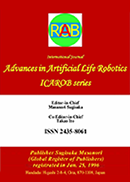Volume 2, Issue 2
Journal of Advances in Artificial Life Robotics
Displaying 1-10 of 10 articles from this issue
- |<
- <
- 1
- >
- >|
-
2021 Volume 2 Issue 2 Pages 53-57
Published: 2021
Released on J-STAGE: October 05, 2022
Download PDF (612K) -
2021 Volume 2 Issue 2 Pages 58-62
Published: 2021
Released on J-STAGE: October 05, 2022
Download PDF (795K) -
2021 Volume 2 Issue 2 Pages 63-69
Published: 2021
Released on J-STAGE: October 05, 2022
Download PDF (1569K) -
2021 Volume 2 Issue 2 Pages 70-73
Published: 2021
Released on J-STAGE: October 05, 2022
Download PDF (587K) -
2021 Volume 2 Issue 2 Pages 74-77
Published: 2021
Released on J-STAGE: October 05, 2022
Download PDF (558K) -
2021 Volume 2 Issue 2 Pages 78-82
Published: 2021
Released on J-STAGE: October 05, 2022
Download PDF (845K) -
2021 Volume 2 Issue 2 Pages 83-86
Published: 2021
Released on J-STAGE: October 05, 2022
Download PDF (790K) -
2021 Volume 2 Issue 2 Pages 87-92
Published: 2021
Released on J-STAGE: October 05, 2022
Download PDF (672K) -
2021 Volume 2 Issue 2 Pages 93-97
Published: 2021
Released on J-STAGE: October 05, 2022
Download PDF (869K) -
2021 Volume 2 Issue 2 Pages 98-103
Published: 2021
Released on J-STAGE: October 05, 2022
Download PDF (645K)
- |<
- <
- 1
- >
- >|
